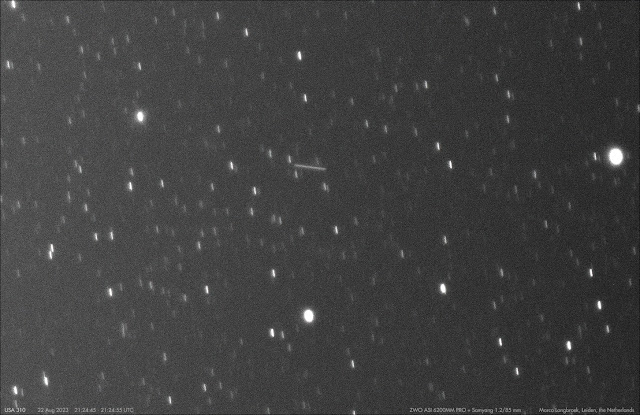 |
| click image to enlarge |
In a recent post I mentioned that I recovered the enigmatic SIGINT satellite PAN/NEMESIS-1 (2009-047A) - we had lost sight of it for about a year - and that it appeared to be stationkeeping at 39.9 E, not far from Express AM-7, when I recovered it mid-August.
It was definitely in a stable position near Express AM-7 in August: but my most recent observations show that PAN has started to drift again, westward. This drift probably was initiated somewhere between September 7 and September 10, 2023, with a drift rate of about 0.16 degrees/day.
Above are four images, from August 22, August 27, September 10 and September 15, 2023 (they are 10 second exposures made by me from Leiden, the Netherlands with a ZWO ASI 6200MM Pro and Samyang 1.2/85 mm lens). If you look at the position of PAN relative to the neighbouring satellites, it is clear that it was stationary between August 22 and August 27, but started to drift after that.
PAN/NEMESIS-1 is a SIGINT satellite with an unusual history of frequent moves in position, and each time it moved it was being positioned very close to a commercial telecommunication satellite.
From it's launch in 2009 until mid 2013, it was repositioned each few months (see my 2016 article in The Space Review).
After mid 2013 it stopped moving and was steady at 47.7 E for many years: untill it started to move again in early 2021.
Our coverage of it has been a bit spotty since that time (with an almost a year long coverage gap between 20 October 2022 and 22 August 2023, when I recovered it again). below is an updated diagram of it's relocations since it's launch in 2009:
 |
| click diagram to enlarge |
The frequent moves between 2009 and 2013 had to do with the unique role of PAN/NEMESIS-1 in the drone war at that time: see this in-depth 2016 article about satellites and the drone war in The Intercept, and my 2016 article in The Space Review for the details.
 |
| PAN launch patch (collection author) |











